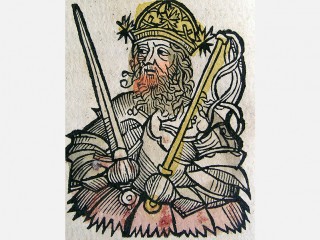
Attila biography
Date of birth : -
Date of death : -
Birthplace : Hunnic Empire
Nationality : Hun
Category : Historian personalities
Last modified : 2010-12-21
Credited as : Ruler of the huns, ,
Attila the Hun(406 - 453) was a chieftain who brought the Huns to their greatest strength and who posed a grave threat to the Roman Empire.
The Huns first appear in European records at the end of the 4th century A.D., when they descended from the Steppes and attacked the Germanic tribes on the northeastern edge of the Roman Empire, either subjecting them or driving them into the empire. By the 430s the scattered nomadic bands had been united into a powerful force which attacked both Germans and Romans alike.
Rua, the man responsible for much of this unity, died in 434 and left the kingdom to his nephews Attila and Bleda. For 10 years they ruled jointly and threatened the Eastern Roman Empire on several occasions. In 435 a "peace" was signed with the Romans, which among other things guaranteed the Huns an annual payment of 700 pounds of gold. In 441 the Huns attacked the provinces across the Danube. In 443 Attila so severely defeated the Roman general Aspar that the Romans had to purchase peace with an annual tribute of 6000 pounds of gold.
In 445 Attila murdered Bleda and united all the Huns under his own leadership. The Roman Priscus, an eyewitness who was an ambassador to Attila's court, describes him as short with a broad chest, flat nose, and beard sprinkled with gray. Attila ruled with absolute authority, his power based in large part on the extensive wealth from his conquests.
War with the Eastern Empire was renewed in 447, and the Romans were defeated in the bloody battle of Marcianopolis. In the peace treaty of 448 they were forced to cede extensive territory along the Danube. Attila then turned his attention to the Western Empire. Geiseric the Vandal urged Attila to attack the Goths so as to remove their pressure on the Vandals, and Attila moved to attack the Visigoths. At the same time the sister of the emperor Valentinian III, Honoria, asked Attila to rescue her from an unwelcome marriage. This gave Attila the excuse to move against Rome. Aetius, the strongman of the Western Empire and one-time hostage of the Huns, created an alliance of Romans and Visigoths, and when the Huns invaded Gaul in 451, he defeated them on the Catalaunian Plains in Champagne.
Although defeated, the Huns escaped destruction and the next year attacked Italy. The important city of Aquileia was destroyed, but Attila did not attack Rome. An embassy from Pope Leo I was credited with dissuading him, but the growing fear of plague and famine probably determined the decision. In 453, while planning another attack on the Eastern Empire, Attila died suddenly from a hemorrhage, reportedly the result of excessive drinking at a wedding. After his death his sons divided his "empire," and the power of the Huns was soon destroyed by internal strife. Attila proved to be a major threat to Rome in his lifetime but left no permanent power to challenge the empire.
The major ancient source on Attila is Priscus, who visited Attila. Fragments of his work are translated in Colin D. Gordon, The Age of Attila (1960). A full account of Attila and the Huns is given by the 6th-century priest and historian Jordanes, The Origin and Deeds of the Goths, translated and edited by Charles C. Mierow (1908; rev. ed. published as The Gothic History of Jordanes, 1915). The best modern account is E. A. Thompson, A History of Attila and the Huns (1948).
















